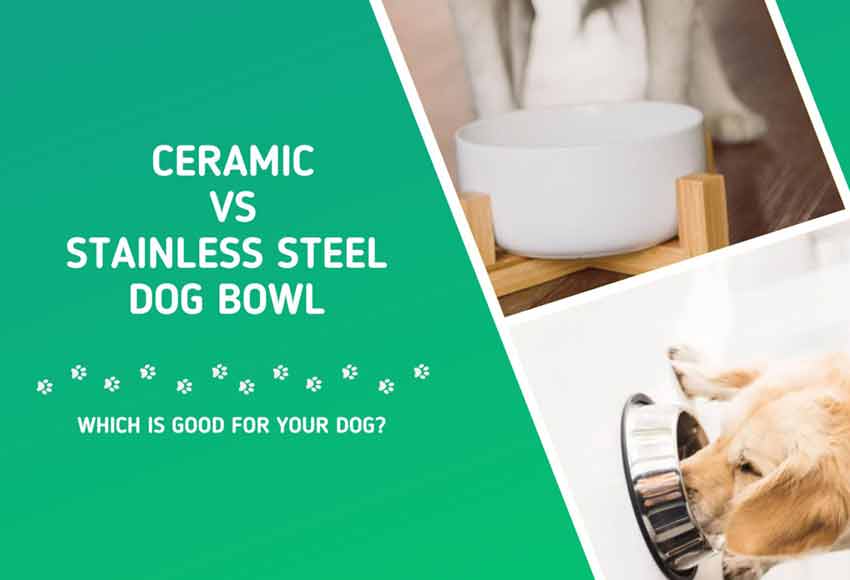Whether you're getting ready to adopt an adorable puppy or have already become a new pawrent, one thing you need to know is that feeders have a huge impact on the health of your "baby", besides the dog food.
I'm sure you've probably done some research, but you may be hesitant to choose between ceramic and stainless steel. Well, luckily for you, this article is to help you out!
Stainless steel vs ceramic, which is the best? Which material is appropriate for your dog? What should you consider when purchasing a dog bowl? Keep reading, and the answers are right there.
Should You Choose Stainless Steel?
Stainless steel is a ferroalloy of iron combined with various elements such as carbon, nitrogen, silicon, aluminum, and nickel. The resulting material has a wide range of properties depending on the specific combination of elements used. For an iron alloy to be stainless, it must contain at least 11 percent chromium, which prevents rust and makes it highly resistant to heat. Increasing the content of chromium or nickel in the alloy can further enhance its antirust performance.
Stainless steel is a great choice for dog bowls because of its superior durability and resistance to rust and scratches. However, like any material, it has its advantages and disadvantages. So, let’s look at the pros and cons of stainless steel dog bowls in detail.
The Pros and Cons of Stainless Steel Dog Bowl

Stainless steel is a popular choice among pet owners when choosing a dog bowl due to its many benefits.
One of the most significant advantages of stainless steel dog bowls is their excellent durability and resistance to rust and scratches. They are highly resistant to scratches and dents, making them perfect for dogs who love to chew or play with their bowls. Plus, stainless steel is easy to clean and doesn't absorb odors, making it a more hygienic choice.
Besides that, stainless steel is relatively inexpensive compared to other materials like ceramic or glass. And they're available in various sizes and shapes to meet your pet's specific needs.
On the downside, stainless steel dog bowls can make noise when bumping against hard surfaces, which may influence some dogs from eating or even staying away from the dog bowl. And some dogs can have allergic reactions to metal, which should be a point to consider. Plus, they can dent easily if they're accidentally dropped or tipped over.
Overall, the pros outweigh the cons of using stainless steel dog bowls, and they are an excellent choice for pet owners looking for a durable, practical, and cost-effective option for their furry friends.
How About Ceramic?
Ceramic pottery is an ancient material that has stood the test of time. This baked clay becomes incredibly hard when exposed to high temperatures, creating a smooth surface that is resistant to scratches. You may also hear this material referred to as earthenware, stoneware, or porcelain, and it's used in everything from home dishes to toilets, vases, and statues.
One of the best things about ceramic is that it's incredibly hygienic. Like stainless steel, it's easy to clean and won't allow bacteria to grow, which means your pet will have a safe and healthy eating environment. Plus, it won't leak harmful chemicals into their food or alter the taste.
However, one downside to ceramics is that they are quite fragile. They can easily break if you handle them roughly or accidentally drop them.
The Pros and Cons of Ceramic Dog Bowl

Ceramic dog bowls are popular among pet owners due to their unique aesthetic and durability. These bowls are made from baked clay that becomes incredibly hard and resistant to scratches when exposed to high temperatures. Here are some of the pros and cons of ceramic dog bowls to help you decide if it's the right choice for your furry friend.
Pros:
- ● Hygienic: Ceramic is easy to clean and does not harbor bacteria, making it a safe and healthy option for your pet's feeding.
- ● Aesthetics: Ceramic dog bowls come in various colors, designs, and shapes, allowing pet owners to choose a bowl that complements their home decor.
- ● Sturdy: Ceramic bowls are sturdy and can withstand the wear and tear of daily use.
- ● Does not leak chemicals: Ceramics does not leak any chemicals into the food, and it does not affect the taste of the food.
- ● Fragile: Ceramic is brittle and can break easily if dropped or handled roughly.
- ● Cost: Ceramic dog bowls can be more expensive than other materials like plastic or stainless steel.
- ● Weight: Ceramic dog bowls are heavier than other materials, making them less convenient for travel or outdoor activities.
Overall, ceramic dog bowls are an excellent choice for pet owners who want a durable and hygienic option that adds a touch of style to their home. However, pet owners should be aware of their fragile nature and take proper precautions to prevent breakage.
Additional Information: Are ceramic bowls safe for dogs?
I guess you must be interested in this question. Usually all the answers we find on the internet say that stainless steel is safe.
It's undoubtedly true, but ceramic is likewise a very safe material. However, there are two conditions that need to be met: one is to comply with quality control regulations; and the second is that if there is a painted pattern, it must be underglazed.
Stainless Steel vs Ceramic Dog Bowls

Now that you know the pros and cons of ceramic dog bowls vs. stainless steel dog bowls, let's compare the differences in detail:
Noise: Ceramic dog bowls are quieter than stainless steel bowls, which clink when pets use them to eat or drink. This may be a consideration for pet owners who are noise sensitive or have pets who are easily startled.
Generally speaking, ceramic and stainless steel dog bowls have their own advantages and disadvantages, and if you want to get a certain answer to the question "Is ceramic or stainless steel better for dog bowls?" I can say: Choose a high-quality ceramic dog bowl if your dog is timid, likes to push the bowl, or has a metal allergy.
Recommended Dog Bowls
Related FAQs: |
How high should a dog bowl be? |
| - In general, the dog bowl stand height should be lower than the dog's lowest chest. We'd like to recommend measuring the dog's wither height first. |
Are slow feeder dog bowls good for dogs?
|
| - Yes, slow-feeder dog bowls can be beneficial for dogs.These bowls slow down dogs' eating speed to prevent bloating, vomiting, and other digestive disorders. |






